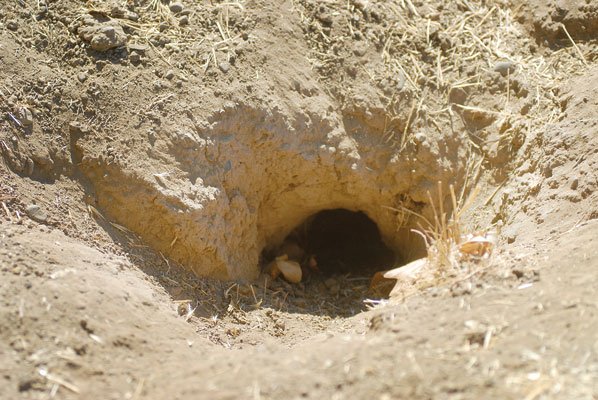It’s mammal versus mammal, and the showdown will take place at
Christmas Hill Park.
It’s mammal versus mammal, and the showdown will take place at Christmas Hill Park.
Exactly when city officials will start combating the hundreds of ground squirrels that scurry and burrow throughout the park is still up in the air, but a host of residents want to bury the burgeoning rodent population because the critters deface manicured landscaping and can carry diseases.
“They’re destroying the park, and I’m just stumped with why we have this problem that we can’t seem to fix,” City Councilman Perry Woodward said. Back when he was 18 and 19, in true “Caddyshack” fashion, Woodward fixed the problem by smoking out squirrel and gopher dens as the summer greenskeeper at the city golf course.
“I’d light the fuse, cover up the hole and then stand back and see little plumes of smoke coming up, sometimes 50 or 75 yards away,” Woodward said. “What has changed? Is it a financial or legal reason? Why are we unable to effectively combat rodents in our city parks now?”
For starters, Gilroy does not have any funds for squirrel control, and its contract with Jensen Landscape Services of San Jose, which maintains and beautifies city parks, only includes limited gopher language, according to Operations Services Manager Carla Ruigh. She said Jensen employees occasionally drop pellets of aluminum phosphide into egregious gopher holes to kill the animals.
“There are few effective and economical methods of squirrel control, and those are typically the use of chemicals,” Ruigh said, adding that the city tries to limit the use of chemicals and pesticides in parks.
Most of the squirrels at Christmas Hill Park congregate near the red barn and baseball field, but Miguel Flores, manager of Jensen Landscape Services, said, “There seems to be less (squirrel activity) this year than the last few years.”
Aside from a lack of funds, the squirrels also catch breaks from humans who find them cute and feed them. Plus, regulatory requirements for euthanasia have increased throughout the decades, burying the days of yore when a town could just employ a few good ole’ boys with Remingtons.
Yes, things have changed – so much so that a couple of California cities have considered birth control.
As part of a two-year experiment beginning in 2004, the city of Berkeley trapped, sedated and injected squirrels at Marina Park with a contraceptive developed by the U.S. Department of Agriculture. The vaccine, at $2 to $10 a pop, prevents ovulation and lactation in female squirrels and stops testicular development in males. Female squirrels birth two to five so-called “kittens” twice per year – in the spring and at the end of summer – but the birth control shot lasts the entire three- to five-year life span of the rodents. In fact, it helped lower the birth rate at the Berkeley park by 66 percent, according to a 2004 U.C. Davis study.
“It was very labor intensive, but the effect was very good,” said Lucia Hui, Alameda county’s chief of environmental health. She added that Berkeley is “one of those cities,” but after the birth control trial, the county stopped controlling the population that has begun “creeping back,” Hui said.
Farther south, Santa Monica recently considered switching over to the pill after Los Angeles county mandated a reduction in squirrel populations. The city ultimately decided to trap the squirrels, euthanize them off site and then send them to a raptor rehabilitation center in Bakersfield for the birds to eat, according to Santa Monica’s Public Landscape Superintendent Darrell Baker.
But Gilroy’s not Santa Monica or Berkeley, and the city council will likely come up with its own strategy after hearing next month about the different options from staff, Ruigh said. By that time, the school district may have some more data to share with the city.
Ascencion Solorsano Middle School sits between the park and Santa Teresa Boulevard, and its proximity to Uvas Creek and the surrounding, though shrinking, agricultural land and hillsides means it shares in the city’s frustration. To deal with that, the district hired Morgan Hill-based Animal Damage Management in July to cover the holes made by the squirrels and to put a substance around the land to kill them, according to Enrique Palacios, deputy superintendent of business services at the Gilroy Unified School District.
“We deal with it the best we can,” Palacios said, adding that the company charged $250 to set-up eight traps, and the district pays the firm $175 a month on an “as needed” basis. The representative from Animal Damage Management authorized to speak about the project was out of town and could not be reached for comment, but Palacios said the chemicals used posed no threat to humans. The company’s Web site claims that the “toxic baits,” fumigants and “chemosterilants” it uses are all approved by the Environmental Protection Agency, Fish and Wildlife and other animal damage control agencies.
Parks and Recreation Commissioner Steve Ashford said he has noticed more squirrels this year, especially during the Garlic Festival, which takes place at Christmas Hill Park.
“I know that (the squirrels) are doing a lot of damage to the park,” Ashford said.
Still, other residents seem to side with Flores, the manager of Jensen Landscape Services.
“I haven’t noticed a problem,” said Stephanie Cowan, a local mother who visits the park. Mando Alfaro said he goes by Uvas Creek and the park area often also, but he has not noticed a problem either.
That could be because they’re hiding, waiting for the right moment to pop out for that nut, undetected.
Staff writer Nicole Baldocchi contributed to this report













